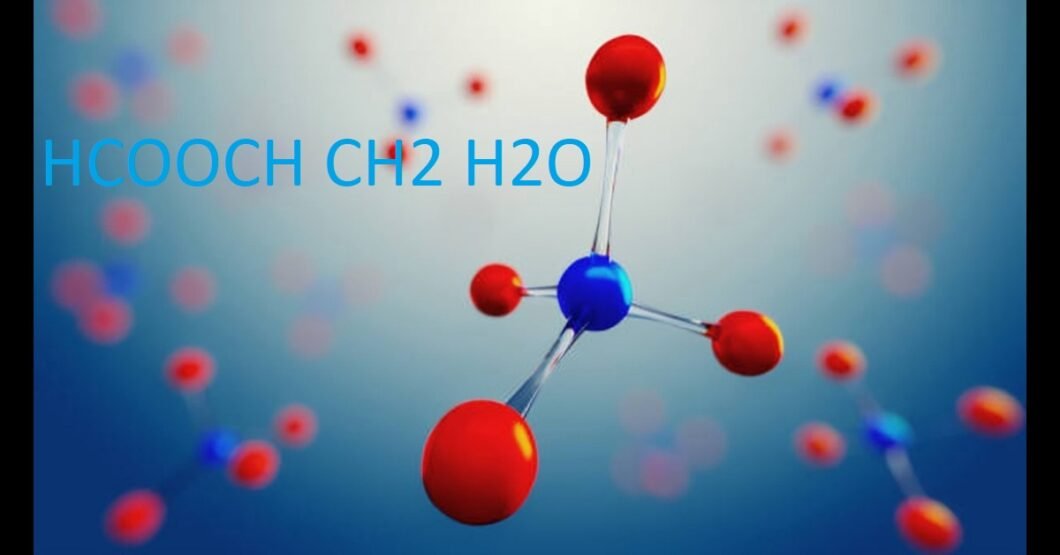Introduction
From the food we eat to the fuels that run our cars, chemistry is present in every aspect of our everyday lives. The relationship between organic compounds and water is one of the many chemical processes that have shaped the contemporary world. HCOOCH (methyl formate), CH₂ groups (methylene), and H₂O (water) are an intriguing combination. The intriguing chemistry of esters, hydrolysis, and organic intermediates is highlighted by these three components.
A simple ester called methyl formate (HCOOCH CH2 H2O) is created when methanol and formic acid combine. As a solvent and chemical intermediary, it is crucial not just in industrial chemistry but also in laboratory synthesis. In contrast, one of the most reactive pieces in organic chemistry is the CH₂ group. It can serve as a building block for fuels, medications, and plastics, depending on its structure. Last but not least, processes like hydrolysis and hydration are brought about by H₂O, the universal solvent.
In this guide, we’ll explore the reaction between methyl formate (HCOOCH₃) and water (H₂O). This is a typical ester hydrolysis reaction, where water breaks an ester into a carboxylic acid and an alcohol.
Let’s understand how this reaction happens – including the molecular equation, reaction mechanism, product formation, and relevance in organic chemistry.
Understanding the Formula HCOOCH CH2 H2O
First, let’s break down this formula in detail.
- HCOOCH stands for Methyl formate (HCOOCH₃), a formate ester.
- The methylene group connected to or participating in the reaction is frequently indicated with CH2.
- Water is a reagent in hydrolysis reactions, and its symbol is H2O.
Thus, HCOOCH CH2 H2O can be understood as a reaction setting in which water (H₂O) and methyl formate (HCOOCH₃) combine in an acidic or basic environment, causing the ester to hydrolyze and break down into simpler organic molecules.
The general ester hydrolysis reaction can be shown as follows:
Ester + Water → Carboxylic Acid + Alcohol
For methyl formate, the reaction looks like this:
HCOOCH3 + H2O → HCOOH + CH3OH
Methanol (CH₃OH) and formic acid (HCOOH) are the products of this process.
Balanced Chemical Equation
Reactants:
Methyl formate (HCOOCH₃) + Water (H₂O)
Products:
Formic acid (HCOOH) + Methanol (CH₃OH)
Full Equation:
HCOOCH3 + H2O → HCOOH + CH3OH
Reaction Type
This is a hydrolysis reaction — specifically acid-catalyzed ester hydrolysis, also known as nucleophilic acyl substitution.
Step-by-Step Reaction Mechanism
Here’s how the reaction occurs:
- Protonation of the Ester Carbonyl
H⁺ acts as an acid catalyst and charges the lone pair of the carbonyl oxygen in HCOOCH₂. This makes the carbon more electrophilic. - Nucleophilic Attack by Water
A water molecule attacks the carbonyl carbon due to its partial positive charge. - Formation of Tetrahedral Intermediate
A rearranged intermediate forms with an extra –OH and –OCH₃ group. - Proton Transfers
Rearrangement happens via proton transfers within the intermediate. - Leaving Group Expulsion
Formic acid is made when the methoxy group (OCH₀⁻) leaves, and methanol (CH₀OH) is made when the methoxy group takes on a proton.
What is HCOOCH (methyl formate)?
- Molecular Formula: HCOOCH₃
- Mass of Molar: 60.05 g/mol
- Appearance: A colorless, transparent liquid with a nice scent
The ester family includes methyl formate. When alcohol and a carboxylic acid combine, esters are created. In particular, the reaction of methanol (CH₃OH) with formic acid (HCOOH) yields methyl formate.
Key properties of HCOOCH CH2 H2O:
- Boiling point: 31.5°C (highly volatile, easily evaporates).
- Solubility: It is soluble in ethers, alcohols, and hydrocarbons but only slightly soluble in water.
- Reactivity: Decomposes to produce beneficial chemicals when acids or bases are present.
Industrial importance of HCOOCH CH2 H2O:
- Utilized as a solvent for cellulose and resins
- Contributes to formamide’s synthesis, a substance found in medications and fertilizers.
- Serves as a bridge in the massive synthesis of formic acid.
The CH₂ Group in Organic Chemistry
The methylene group is the name given to the CH₂ unit. Despite its straightforward appearance, it is incredibly dynamic and adaptable.
Forms of CH₂:
- Methylene carbene (CH₂) – A highly reactive bridge
- CH₂ in alkanes/alkenes – Typical of hydrocarbons such as ethane and ethene
- Polymeric CH₂ chains – Present in polyethylene and other polymers
Why it matters:
- Fuel industry: The building blocks of natural gas, diesel, and gasoline are hydrocarbons, which are chains of CH₂ molecules.
- Plastics: In packaging, polyethylene (-CH₂–CH₂–) is one of the most popular plastics.
- Reactions: CH₂ groups are essential in synthesis because they take part in addition, substitution, and polymerization processes.
Role of Water (H₂O) in Organic Reactions
Since it dissolves more things than any other liquid, water is frequently referred to as the universal solvent. Water is both a medium and a reactant in organic chemistry.
Main roles of H₂O:
- Hydrolysis: Using water to break chemical bonds
- Hydration: Water is added to unsaturated molecules, such as when alkenes are converted to alcohols.
- Medium for reactions: A lot of industrial and biological activities need watery environments.
Hydrolysis of HCOOCH with Water
Hydrolysis is one of the most significant reactions of methyl formate (HCOOCH CH2 H2O).
HCOOCH₃+ H₂O → HCOOH + CH₃OHHCOOCH3+H2O → HCOOH+CH3OH
This means:
- Methyl formate (HCOOCH₃) + Water (H₂O) → Formic Acid (HCOOH) + Methanol (CH₃OH).
Conditions:
- Acidic hydrolysis: H⁺ (acid catalyst) is used.
- Basic hydrolysis (saponification): OH⁻ is used as a base catalyst.
Formic acid, a chemical utilized in agriculture, rubber production, and leather processing, is produced by this reaction and is used extensively in industry.
Industrial Applications of Methyl Formate Hydrolysis
Such hydrolysis reactions are not merely lab experiments; they are the engine of industrial operations.
Applications include:
- Production of formic acid, an antimicrobial and preservative in animal feed
- Recovery of methanol (a feedstock for chemicals and fuel)
- Pharmaceutical intermediate
Example table:
| Compound | Hydrolysis Product | Application |
| Methyl Formate (HCOOCH₃) | Formic acid + Methanol | Industrial solvent, agriculture |
| Ethyl Formate (HCOOCH₂CH₃) | Formic acid + Ethanol | Flavorings, perfumes, biofuels |
CH₂ in Industrial Reactions
Several of the most significant chemical (HCOOCH CH2 H2O) businesses rely heavily on the CH₂ group.
Uses:
- Polymerization: Makes polyethylene and polypropylene plastics.
- Fuel chemistry: Energy is released through the combustion of hydrocarbons having CH₂ units.
- Organic synthesis: Reactive intermediates aid in the formation of more complex, bigger molecules.
Industries like gasoline, textiles, and plastics would not function as they do now without CH₂ groups.
Safety and Environmental Impact
Methyl formate and related esters are helpful, although managing them carefully is necessary.
Safety:
- Both flammable and volatile
- Can irritate the eyes and skin.
- Needs adequate ventilation when in use.
Environmental impact:
- Methanol and formic acid, byproducts of hydrolysis, are biodegradable.
- Long-term contamination is avoided with controlled use.
Future of Ester Chemistry
Esters like methyl formate (HCOOCH CH2 H2O) are becoming more and more significant as sustainable substitutes as green chemistry gains traction.
Researchers concentrate on:
- Plant-based bio-based production
- Faster hydrolysis using catalysts
- Natural esters are used to make safer solvents.
This suggests that HCOOCH, CH₂, and H₂O reactions will become even more important in sustainable sectors in the future.
FAQs
What does HCOOCH₃ mean?
Ethers like formic acid and methanol are what make up methyl formate.
This is what kind of response it is?
A nucleophilic acyl swap is caused by acid breaking down an ester.
What do you get when you mix HCOOCH₃ and H₂O?
Methanol (CH₃OH) and formic acid (HCOOH)
Can this response go the other way?
Yes. The opposite process, esterification, can happen in some situations, like when there is too much alcohol.
Where in the real world is methyl formate used?
in the manufacturing of formic acid, chemicals, solvents, and medications.
Conclusion
Methyl formate (HCOOCH CH2 H2O) chemistry offer a great window into how chemical reactions influence our day-to-day existence. These chemicals and their interactions highlight the significance of methylene reactivity and ester hydrolysis from the lab to the manufacturing floor.
One important industrial process is the hydrolysis of methyl formate, which yields two valuable compounds used in fuels, medicines, and agriculture: methanol and formic acid. In addition, CH₂ groups are the fundamental units of energy systems, polymers, and a myriad of other synthetic materials that characterize contemporary society.
We can observe how something as basic as water may change organic compounds into goods that support businesses and improve daily living by comprehending these processes. These reactions are expected to become increasingly more significant in the future as interest in sustainable chemistry grows.
Visit the rest of the site for more interesting and useful articles.




